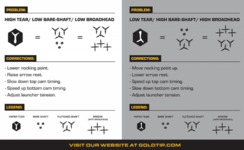You are correct that you want the rest in line with the path traveled by the nocking point from full draw to brace. The manifestation of left/right misalignment between the rest and string path and the adjustments needed to correct it seemed counterintuitive to me until I watched a video in the Bow Shop Bible app that shows what's going on in slow motion. I attempted to explain what the video shows in the sketch below, but the video itself is worth a million words (and the price of the app).
View attachment 540213
The conditions shown in the sketch would produce a nock left paper tear, bareshaft right of fletched shaft, and broadhead right of field point, which would all be fixed by moving the rest to the right (or by moving the cams to the left via shimming or yoke tuning). The seemingly counterintuitive left/right tuning adjustments now make perfect sense to me after seeing what's actually happening in slow motion.
Dynamic bending of the arrow shaft also plays a role, which I didn't attempt to include in my illustration. Rest type is also a factor: the longer the arrow and rest are in contact, the more pronounced the effect of misalignment between the rest and string path.


